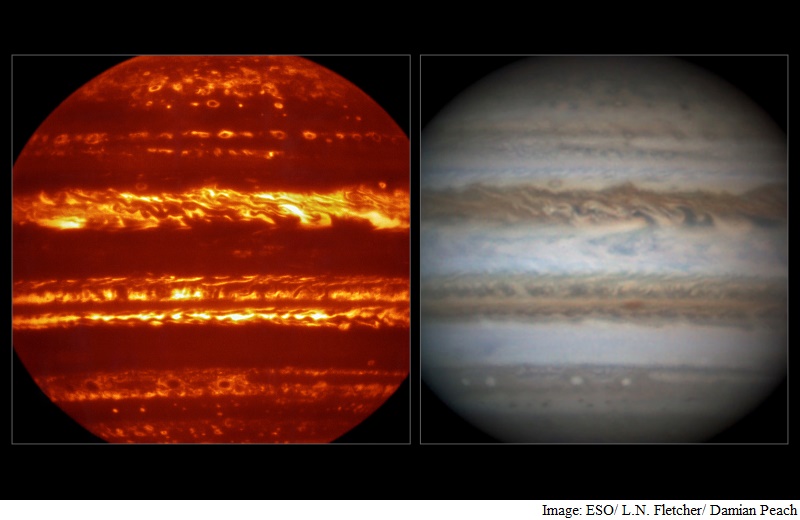- Home
- Science
- Science News
- Stunning Images Reveal Jupiter Ahead of Juno's Arrival
Stunning Images Reveal Jupiter Ahead of Juno's Arrival

The images were captured at the thermal infrared wavelengths using a newly-upgraded thermal imager called VISIR.
"We used a technique called 'lucky imaging', whereby individual sharp frames are extracted from short movies of Jupiter to 'freeze' the turbulent motions of our own atmosphere, to create a stunning new image of Jupiter's cloud layers," said Leigh Fletcher from University of Leicester.
"At this wavelength, Jupiter's clouds appear in silhouette against the deep internal glows of the planet. Images of this quality will provide the global context for Juno's close-up views of the planet at the same wavelength," he added.
Jupiter's high resolution maps, which reveal the present-day temperatures, composition and cloud coverage within the planet's dynamic atmosphere, and show how giant storms, vortices and wave patterns shape its appearance, will help set the scene for what Juno will witness in the coming months.
The ground-based campaign in support of Juno is led by Glenn Orton of Nasa's Jet Propulsion Laboratory.
Once in orbit around Jupiter, Juno will skim just 5,000 km above Jupiter's clouds once a fortnight - too close to provide global coverage in a single image.
The Earth-based observations supplement the suite of advanced instrumentation on the Juno spacecraft, filling in the gaps in Juno's spectral coverage and providing the wider global and temporal context to Juno's close-in observations.
Fletcher presented the observations at the National Astronomy Meeting in Nottingham on Monday.
Catch the latest from the Consumer Electronics Show on Gadgets 360, at our CES 2026 hub.
Related Stories
- Samsung Galaxy Unpacked 2025
- ChatGPT
- Redmi Note 14 Pro+
- iPhone 16
- Apple Vision Pro
- Oneplus 12
- OnePlus Nord CE 3 Lite 5G
- iPhone 13
- Xiaomi 14 Pro
- Oppo Find N3
- Tecno Spark Go (2023)
- Realme V30
- Best Phones Under 25000
- Samsung Galaxy S24 Series
- Cryptocurrency
- iQoo 12
- Samsung Galaxy S24 Ultra
- Giottus
- Samsung Galaxy Z Flip 5
- Apple 'Scary Fast'
- Housefull 5
- GoPro Hero 12 Black Review
- Invincible Season 2
- JioGlass
- HD Ready TV
- Laptop Under 50000
- Smartwatch Under 10000
- Latest Mobile Phones
- Compare Phones
- Honor Win RT
- Honor Win
- Xiaomi 17 Ultra Leica Edition
- Xiaomi 17 Ultra
- Huawei Nova 15
- Huawei Nova 15 Pro
- Huawei Nova 15 Ultra
- OnePlus 15R
- Asus ProArt P16
- MacBook Pro 14-inch (M5, 2025)
- OPPO Pad Air 5
- Huawei MatePad 11.5 (2026)
- Xiaomi Watch 5
- Huawei Watch 10th Anniversary Edition
- Acerpure Nitro Z Series 100-inch QLED TV
- Samsung 43 Inch LED Ultra HD (4K) Smart TV (UA43UE81AFULXL)
- Asus ROG Ally
- Nintendo Switch Lite
- Haier 1.6 Ton 5 Star Inverter Split AC (HSU19G-MZAID5BN-INV)
- Haier 1.6 Ton 5 Star Inverter Split AC (HSU19G-MZAIM5BN-INV)

















